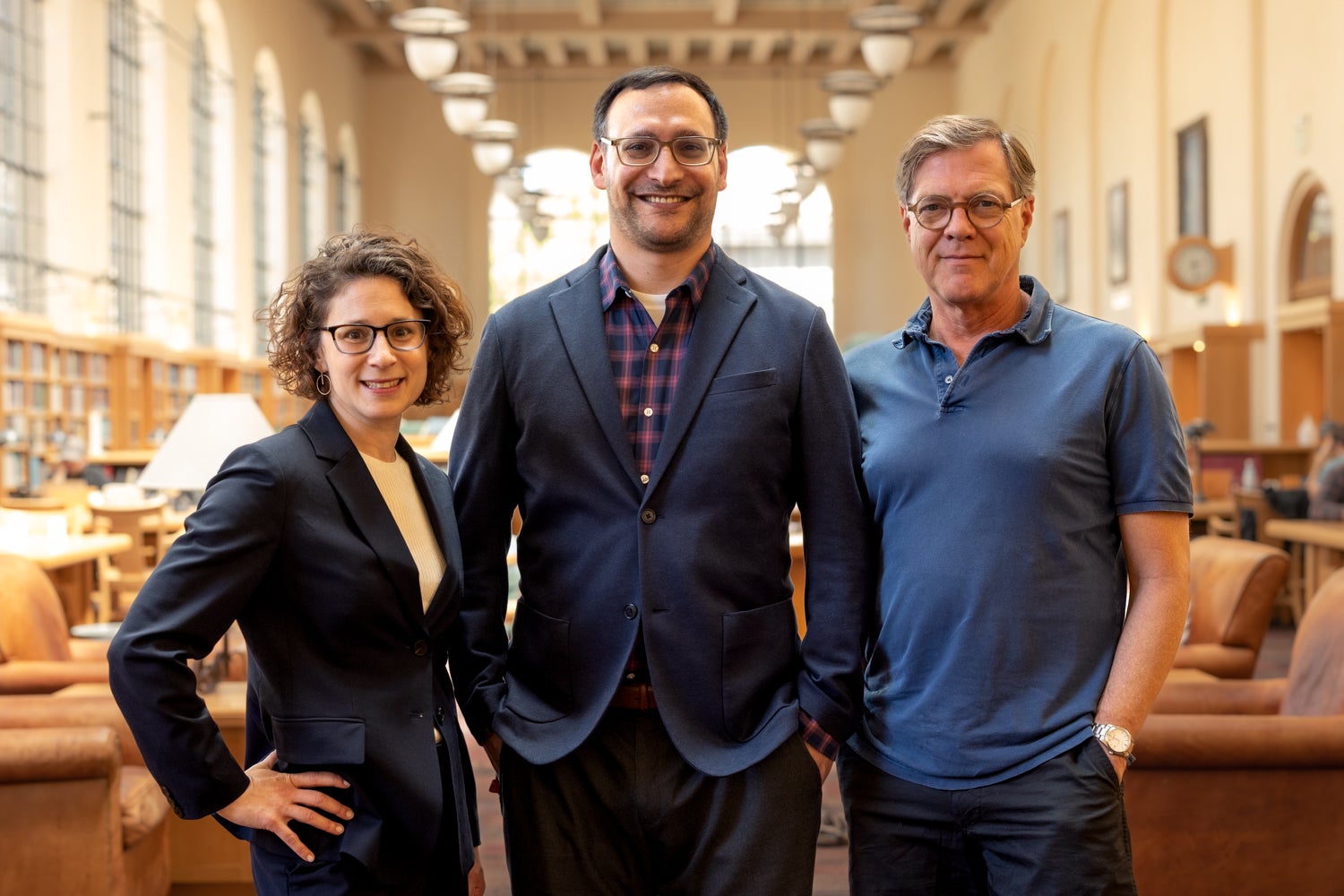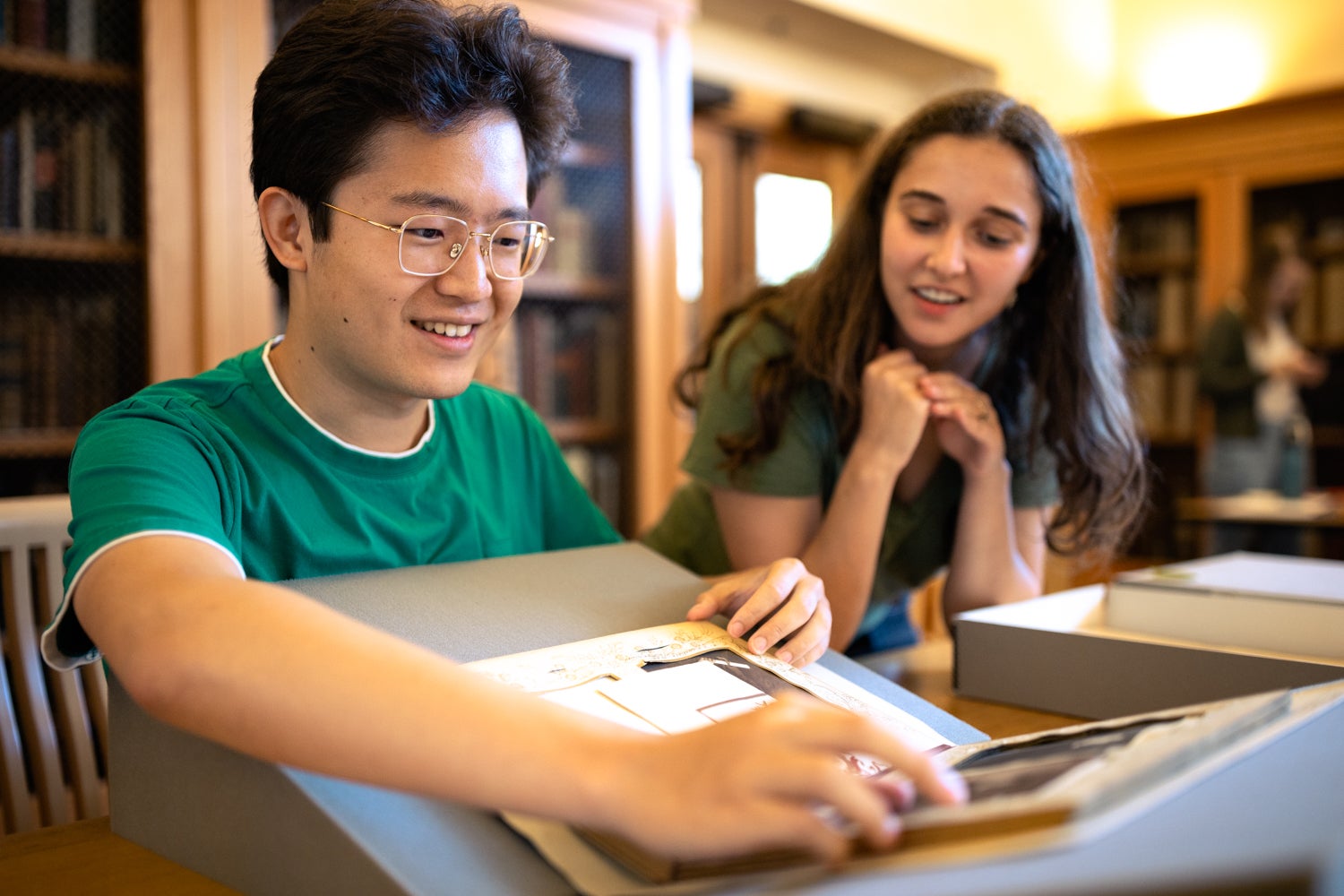Teaching Stanford’s history
A new spring quarter course examined Stanford’s past, including the people, personalities, and politics that have made the university what it is today.
How would you describe how the Stanford campus looks and feels?

Over spring quarter, Stanford scholars Emily J. Levine, Josh Schneider, and Mitchell Stevens co-taught a new course that examines Stanford history and the different ways to tell it. (Image credit: Andrew Brodhead)
This was a question Stanford sociologist Mitchell Stevens posed to his students one afternoon by Meyer Green, a grassy area near the Law School and Green Library.
Students had gathered for a walking tour Stevens was leading as part of a new course he is co-teaching with historian Emily J. Levine, Education 147: Stanford and Its Worlds, 1885–Present, which examines how Stanford’s past has informed the present.
Students’ answers to Stevens’ question were varied – one person described its many trees, another the distinctive sandstone walls and clay-colored roofing – but they revealed how there are many ways to describe the campus.
“Stanford has transformed several times in the period of its relatively short, 125-year history – it gives us a lot to think about,” said Stevens, a professor in the Graduate School of Education.
Stevens’ tour was one of many different activities that engaged students with Stanford’s past. In addition to attending lectures, there were also visits to the Cantor Arts Center and the University Archives. Students could also take a companion course with the university archivist, Josh Schneider, to work with original documents.
Levine, Schneider, and Stevens, along with Abigail Kahn, a PhD student in the history of education and the course’s teaching assistant, talked about how the university has influenced and been shaped by the American West, the global academy, the nation-state, national student culture, and Silicon Valley.
“The goal of the class is to think about the role and responsibility of Stanford in relationship to different groups of people and the webs of relationships that have played out over time, and what all of it means for today,” said Levine, an associate professor of education.
Re-examining Stanford’s founding
The course opened with an examination into the Stanfords themselves. Who were they? What brought them to California? How was their success implicated in the expansion of the American West?
And more broadly: How do people muster the hubris of starting a university from scratch – as a number of rich people did in the late 19th century – and to what end? What does it mean for private wealth to be “given” to wider society?
The Stanfords, originally from Albany, New York, moved to California in 1852 during the height of the Gold Rush, a period that saw rapid change across the region. Leland Stanford made a name for himself in this new world, becoming governor in 1861 and later serving as a U.S. senator in 1885 until his death in 1893. But it was through Leland Stanford’s role building the First Transcontinental Railroad – critical infrastructure that connected eastern U.S. rail networks to the West Coast – where he amassed his fortune.
The West the Stanfords inhabited was “wild” – rugged and rural – but Leland, with a confidence and swagger not too dissimilar to the entrepreneurs of Silicon Valley today, offered the tools and technology to tame it. Here, Stanford’s pitch deck entwined itself with the California dream, presenting the American West as both a place of endless possibility as well as a geographic destination.
“Frontier businessmen had to make lots of promises: ‘Tomorrow is going to be really big,’ ‘You’ve never seen anything like it,’ and ‘This particular place I am selling you on is going to be worth it,’” said Stevens.
Putting an institution – like a university – onto the map was a way to imbue a place with those promises.

Kene Nzelu, a junior majoring in history, pores over items from the Stanford University Archives for her final project that looks at the role of women in Stanford’s history. (Image credit: Andrew Brodhead)
“There’s a reason why so many towns and cities across the country have a college or a university,” Stevens explained. “It was a way of establishing ownership and proprietary, even dominion, over a particular locale.”
As students also learned, there is a reason why the campus has its distinctive look and feel: The Stanfords wanted their remote outpost to be bigger and bolder than their institutional rivals on the East Coast and in Europe. They brought on Frederick Law Olmsted, the renowned landscape architect of New York City’s Central Park, to design it, riding on his reputation as a way of building their own (even though the Olmsted-Stanford relationship was a fraught one and the campus bears little resemblance to Olmsted’s original plan).
The Stanfords also had a particular vision for their university.
Kene Nzelu, a junior majoring in history, was surprised to learn about what education model influenced the Stanfords. She expected Harvard and Yale to be their inspiration, but it was the more upstart, research-oriented schools of the time – Cornell, Johns Hopkins, and MIT – that the Stanfords chose to emulate.
“The Stanfords wanted to make sure the university was research focused,” Nzelu said. “You can see parallels to how Stanford is a front runner in research today.”
Confronting difficult histories
There are many layers to Stanford’s founding, which students also examined.
The period the Stanfords lived in was one also defined by brutal violence against non-whites and the destruction of cultural, economic, and religious practices of Indigenous communities, including the displacement of the Muwekma Ohlone people native to the region that would one day become Silicon Valley. While no known settlements of the Ohlone people were on the land when the Stanfords purchased it, further research may reveal evidence Native Americans lived in remote areas of the foothills. Due partly to the Stanfords’ influence, the region underwent a near total transformation in the industrial and capitalistic project of western expansion.
For one assignment, students analyzed the Stanford University Indigenous Land Acknowledgment that was developed in collaboration with the Muwekma Ohlone. Students talked about how it was an important, active contribution, but some, including Nzelu, wanted to see the university do more.
As Nzelu explained, confronting the past is also part of how to transcend it.
“Talking about these things can be difficult but it’s important that we don’t hide the history,” Nzelu said. “Now that we’re learning all of these additional things, how do we make Stanford better? How do we repair relationships with groups of people that we need to repair? What could Stanford do to right its wrongs from the past?”
The idea to have a course dedicated to Stanford’s history grew out of work Levine, Stevens, and others did through their involvement in a special task force chaired by Ari Y. Kelman, which researched and confirmed an allegation that Stanford, particularly one admissions officer, limited Jewish student enrollment during the 1950s.
“We developed this idea – that was already growing – that our approach to the university’s history should not simply be limited to isolated responses to institutional or individual complaints, but rather should be an ongoing, more collaborative telling and retelling of our past,” said Levine. “We should be making a pedagogical intervention into the institution – to bring the history of the university more to the center of the curriculum.”

Abigail Kahn, a PhD student in the history of education and the course’s teaching assistant, and Zhaoyi Li, a senior majoring in physics, look at archival records from the Japanese Students Association. (Image credit: Andrew Brodhead)
Much of this difficult history has always been there – it just hasn’t always been told, said Schneider, who guided students through the archival and primary source materials at the Stanford Libraries for the companion class, Education 147L: Stanford Archive Lab.
Recent research, such as that by Stanford scholars Richard White, Gordon Chang, and Shelley Fisher Fishkin, to name a few, has turned to the archives to help uncover some of these previously untold stories. For example, in their research about Chinese labor on the Central Pacific Railroad, Chang and Fishkin studied payroll records and correspondence from Leland Stanford to learn more about the hardships these Chinese workers faced, including receiving lower wages and experiencing harsher working conditions than their white counterparts.
“We want the archives to support challenging and retelling Stanford’s histories,” said Schneider. “Materials in the archives can tell a very different story than the ones students and alums might remember from when they first came to Stanford.”
In recent years, Stanford, like other older institutions across the United States, has been reckoning with its own complex and at times painful history. For example, the prominence of Stanford’s first president, David Starr Jordan, in the eugenics movement has left the university with a challenging legacy, a subject that was examined in Levine and Stevens’ course as well.
“We have a deep sense of responsibility for how we understand this institution and its historic role and responsibility in American life and its ongoing obligation to contribute to the public good,” Levine said.